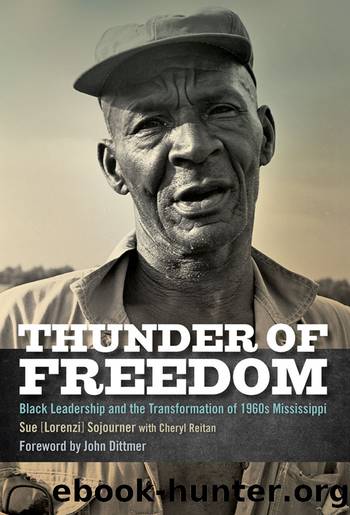Thunder of Freedom by Sue

Author:Sue [Lorenzi] Sojourner, Cheryl Reitan [Sue [Lorenzi] Sojourner, Cheryl Reitan]
Language: eng
Format: epub
Tags: Biography & Autobiography, Social Activists, History, United States, State & Local, South (AL; AR; FL; GA; KY; LA; MS; NC; SC; TN; VA; WV), Political Science, Civil Rights
ISBN: 9780813140940
Google: imY1EAAAQBAJ
Barnesnoble:
Publisher: University Press of Kentucky
Published: 2013-02-08T00:00:00+00:00
Curtis "Ollie" Hoover, from a rural area south of Lexington, was a steady movement worker.
The workshops were usually held in the evening after everyoneâs mealtime, almost always in a church. Ten or twelve people would attend, though sometimes only four or five; some folks arrived early and others straggled in late. Usually a preacher would open with a prayer and turn the workshop over to the local leader and Henry. In the eastern hill region, for example, Austin Wiley was the leader in Mount Olive, Willie Mae Wright and her husband George were the strong Sunnymount leaders, and Vanderbilt Roby, aided by his wife Cora, were the Old Pilgrims Rest pillars.
The Holmes County FDP was one of the strongest FDP organizations in the state, having a very good working relationship with the state MFDP. When a state-level campaign, action, or response was needed or planned, MFDP chairman Guyot or other state-level workers would communicate with Henry and with Ralthus Hayes. By 1966 Guyot and other FDP workers also had contact with Howard Taft Bailey from Old Pilgrims Rest and Walter Bruce from Durant, who had both developed into strong local leaders. The Holmes leaders in turn might inform Guyot of Holmes plans and needs and get advice and suggestions. Because he had access to the office phone and sometimes attended Jackson meetings, Henry was in touch with Guyot more regularly than the Holmes leaders were, although they too had their own connections with Guyot and the state movement.
Because much more work was under way, we hoped the countyâs FDP could soon stand on its own, increasingly taking over more planning and strategizing. The many activities centered around the antipoverty programs of late 1965 and early 1966 added complexity to our already not-so-simple life. With regular weekly meetings in fifteen different communities and a monthly countywide meeting that met each third Sunday in a different one of those communities, the Holmes FDP clearly was developing into an extremely active and well-organized movement.
At the same time we were seriously planning for 1967, when local elections would be held for offices in the county and its five election districts or âbeats.â These elections were the first in which new black voters could have a real chance to meaningfully participate. If enough blacks could get registered by then, our hopeâindeed our dreamâwas to elect some black officials.
Blacks had been given the vote through the duration of the 1867â1877 Reconstruction Act and then completely lost the right to vote at the 1890 Mississippi Constitutional Convention. Through our work, blacks could now, in effect, be elected to take office in Mississippi for the first time in seventy-seven years. Movement people were taking leadership roles at their weekly meetings, in the schools, in the communities, and in the churches. They were raising money. Although modest, the funds collected at meetings and âplate dinnersâ helped pay for the FDP officeâs phone, rent, lights, some supplies, and gasoline. Because the Holmes FDP emphasized organizing rather than confrontational politics, it became a force in developing the new federally funded antipoverty programs.
Download
This site does not store any files on its server. We only index and link to content provided by other sites. Please contact the content providers to delete copyright contents if any and email us, we'll remove relevant links or contents immediately.
The Secret History by Donna Tartt(18160)
The Social Justice Warrior Handbook by Lisa De Pasquale(11952)
Thirteen Reasons Why by Jay Asher(8451)
This Is How You Lose Her by Junot Diaz(6436)
Weapons of Math Destruction by Cathy O'Neil(5829)
Zero to One by Peter Thiel(5489)
Beartown by Fredrik Backman(5356)
The Myth of the Strong Leader by Archie Brown(5238)
The Fire Next Time by James Baldwin(5016)
How Democracies Die by Steven Levitsky & Daniel Ziblatt(4958)
Promise Me, Dad by Joe Biden(4908)
Stone's Rules by Roger Stone(4857)
100 Deadly Skills by Clint Emerson(4690)
A Higher Loyalty: Truth, Lies, and Leadership by James Comey(4550)
Rise and Kill First by Ronen Bergman(4545)
Secrecy World by Jake Bernstein(4388)
The David Icke Guide to the Global Conspiracy (and how to end it) by David Icke(4380)
The Farm by Tom Rob Smith(4323)
The Doomsday Machine by Daniel Ellsberg(4245)
